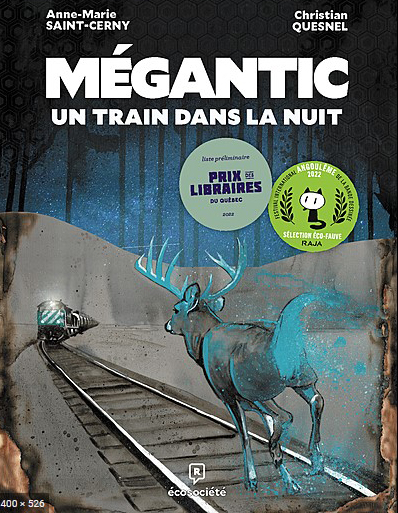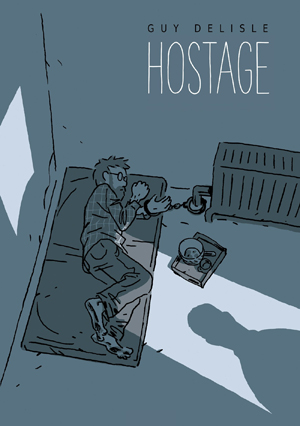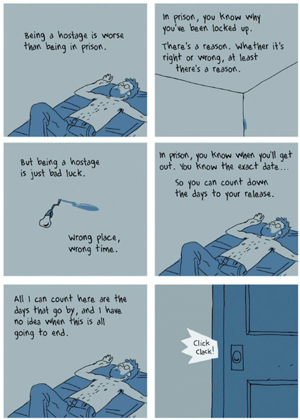
We have all heard of the tragedy experienced by the inhabitants of Lac-Mégantic in 2013, when a driverless oil train from the CP railway company pulling hundreds of cars of explosive petroleum derails in the middle of the night, explodes and kills 47 inhabitants of the city.
The comic book (or graphic novel according to some) “Mégantic – Un train dans la nuit ” adds to the information that we already knew about this tragedy. It also exposes several key pieces of information overlooked by the media.
Author Anne-Marie Saint-Cerny worked for years on the file and, in order to convey the content and the emotions in images, enlisted the help of Christian Quesnel. The result is extremely interesting. The formula works: the drawings are very precise, the layout leaves room for the reader to reflect on the events, the colours are appropriate.
In the train explosion in Lac-Mégantic, there are multiple factors to consider, among others:
1) Executives of the CP company making catastrophic choices.
2) As always, a desire to meet the demands of shareholders. There is a reduction in staff and the company self-assesses when it comes to safety.
3) One driver only is allowed for a train carrying hundreds of tanks of explosives.
4) Politicians agree to the new cuts proposed by the company.
5) There is some magical thinking involved: if something goes wrong with the driver, the train stops on its own thanks to a mechanism which, however, is always likely to fail eventually.
6) Dated rails.
7) The transport of dangerous goods is granted to the MMA, a company with a dubious reputation .
8) The DOT-111 tanks are too fragile for hazardous materials and targeted in more than 25 surveys.
9) There is an agreement to tamper with the oil bill of lading. Instead of indicating the code PG1 (the most dangerous, the most explosive) as it should be, it is instead PG111 (not dangerous) that is written.
10) The lead locomotive is terribly worn.
11) The driver reports a problem with his old locomotive. He is ordered to continue on his way.
12) In Lac-Mégantic, the train is heating up. The driver is ordered to apply the brakes and let the engine run. The driver is then allowed to leave the premises and go to bed. This is one of the repercussions of allowing a single driver on a train.
13) During the night, a fire starts on the lead locomotive, the one that had problems. The firefighters shut down the engine. “By turning off the engine, the air pressure in the air brakes is released. Eventually, the train will start to move on its own and descend the slope towards Lac-Mégantic.”
With just one driver gone to sleep somewhere, there are now 5,000,000 litres of explosives starting to move on the rails and no one will stop them.
“Firefighters believe they are fighting low flammable oil. They are unaware that the CP and World Fuel have falsified the papers, camouflaging their oil classified as the most explosive and dangerous.” There are 47 dead, including several suicides.
Now that there has been a disaster, those involved directly or indirectly are passing the buck, as is the custom in tragedies. The graphic novel mentions, at the political level, the names of Denis Lebel, Lisa Raitt, John Baird and later Marc Garneau. At CP, the author mentions Hunter Harrison. The MMA’s CEO Edward Burkhardt is also mentioned.
Changes happen, but not the ones you would think…
Naomi Klein analyzes the “shock strategy” devised by Milton Friedman. In step 1, “we take advantage of what the population while it is still dazed: they will not be able to oppose what we want to impose on them.” The zoning is being quickly changed to include the expropriation of houses that are totally outside the disaster-affected area. There are some people who are interested in these properties…
In step 2 of the “shock strategy”, we “use the excuse of mandatory decontamination to wipe out the Old World. Excluding the population from the scene of the tragedy, so that they cannot cling to it, so that there is no going back. “
Finally, step 3: “Faced with a population whose shock has been exacerbated by the destruction of its landmarks and habits, we can launch a reconstruction or reinvention which will be received with resigned acceptance“. We have the case of people living in Fatima, a remote area spared by the disaster: owners must quickly sign their expropriation or they shall lose everything. When the former owners are finally gone, a Jean Coutu pharmacy comes to settle on the vacated land.
On the legal side, the small players are targeted and the investigation is limited as much as possible. Takeovers are carried out and returns to shareholders multiplied.
The book flaunts some of the political and entrepreneurial maneuvers aimed at protecting the railway companies. Even at the dawn of 2022, eight years later, the rails still pass through downtown Lac-Mégantic.
“MMA-Canada, essentially bankrupt, has paid nothing and has not been sued.“
“Nothing has changed in rail laws in Canada since the tragedy: companies self-regulate, self-monitor and, in the event of an accident, self-investigate. Thus, it was the CP itself that investigated the deaths of three of its employees in an accident in February 2019 in British Columbia. The CP investigator, prevented from investigating, denounced his employer and called for an independent investigation by the Royal Canadian Mounted Police (RCMP) and the Transport Safety Board (TSB), an investigation immediately accepted by the chief investigator responsible for the case at the TSB. That same day, this TSB investigator was dismissed from his post. The CP investigator concluded on a CP no-fault.”
Title: Mégantic – Un train dans la nuit
Author: Anne-Marie Saint-Cerny
Edition : Écosociété, 2021
ISBN : 978-2-89719-686-8
Click on the link for more graphic novels and comic books on my blog.

